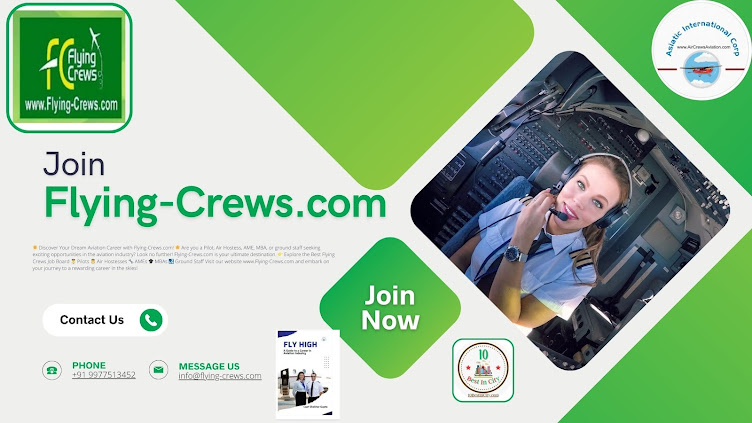A Comprehensive Guide to Becoming an Airline Pilot in the United States
"Charting the Course:
A Comprehensive Guide to Becoming an Airline Pilot in the United States"
The journey to becoming an airline pilot in the United States is an exhilarating adventure that demands dedication, skill, and a passion for aviation. This comprehensive guide will navigate through the roles, requirements, qualifications, benefits, and frequently asked questions to provide aspiring pilots with a roadmap for their aviation career.
### Roles:
*1. First Officer (Co-Pilot):*
The First Officer, also known as the Co-Pilot, plays a crucial role in assisting the Captain in operating the aircraft. They are responsible for specific duties during flights, ensuring a smooth and safe journey for passengers and crew.
*2. Captain (Commander):*
The Captain, or Commander, is the leader of the flight crew and holds ultimate responsibility for the safety and operation of the aircraft. They make critical decisions during flights and lead the crew in various operational aspects.
*3. Check Airman/Instructor:*
Experienced pilots often take on roles as Check Airmen or Instructors. These individuals are responsible for training and evaluating other pilots, ensuring that they meet the high standards set by aviation authorities and the airline.
### Requirements and Qualifications:
#### 1. Educational Requirements:
While a college degree is not always mandatory, many airlines prefer candidates with a higher education background. A high school diploma or equivalent is the minimum requirement.
#### 2. Age Requirements:
To pursue a career as an airline pilot in the United States, individuals must be at least 21 years old. This age requirement aligns with the minimum age for obtaining an Airline Transport Pilot (ATP) certificate, the highest level of pilot certification.
#### 3. Flight Training and Certification:
The journey begins with obtaining a Private Pilot License (PPL) followed by an Instrument Rating and Commercial Pilot License (CPL). Aspiring pilots then accumulate flight hours, aiming for a minimum of 1,500 total hours to qualify for the ATP certificate. This progression involves gaining experience in various aircraft, mastering different flight conditions, and demonstrating proficiency in advanced flight maneuvers.
#### 4. Medical Requirements:
Aviation safety is paramount, and pilots must pass a Class 1 aviation medical exam conducted by an FAA-authorized medical examiner. This thorough examination assesses both physical and mental fitness, ensuring pilots are fit to operate aircraft.
#### 5. Additional Skills:
Airline pilots need strong communication and decision-making skills. The ability to work effectively in a team-oriented environment is crucial, as cockpit crews rely on clear and concise communication to ensure safe and efficient operations.
#### 6. Experience:
The path to becoming an airline pilot involves gradual progression through different certifications and accumulating flight hours. Pilots gain experience in a variety of roles, starting from private pilot positions and progressing to commercial pilot roles before achieving the coveted ATP certificate.
### Benefits:
#### 1. Competitive Salaries:
Airline pilots enjoy competitive salaries, often accompanied by benefits such as health insurance, retirement plans, and travel privileges. The compensation reflects the responsibilities and skills required for the role.
#### 2. Global Opportunities:
One of the most appealing aspects of being an airline pilot is the opportunity to travel to diverse destinations globally. Pilots experience different cultures, climates, and landscapes, making each assignment a unique adventure.
#### 3. Job Stability:
Despite fluctuations in the economy, the demand for skilled airline pilots remains relatively stable. Airlines require a consistent workforce to meet the ever-growing demands of air travel.
#### 4. Career Advancement:
The aviation industry offers numerous opportunities for career advancement. Experienced pilots may progress to captain positions, take on specialized roles within the airline, or explore leadership positions.
#### 5. Professional Development:
Continuous training is a fundamental aspect of a pilot's career. Pilots undergo recurrent training to stay current with evolving aviation technologies, new procedures, and regulatory changes, ensuring they are well-equipped to handle any situation.
### Frequently Asked Questions (FAQs):
*Q1: How long does it take to become an airline pilot in the U.S.?*
The duration varies, but on average, it takes several years. Factors influencing the timeline include the type of pilot's license, the frequency of training, and individual progress. The journey involves acquiring a Private Pilot License, progressing to a Commercial Pilot License, and finally obtaining the ATP certificate, accompanied by accumulating the required flight hours.
*Q2: Can I become an airline pilot without a college degree?*
While a college degree is not mandatory, many airlines prefer or may even require candidates to have a degree. A higher education background is often seen as an asset and can enhance one's competitiveness in the job market.
*Q3: Are there age limits for becoming an airline pilot?*
The minimum age for obtaining an ATP certificate, which is necessary for serving as a captain on commercial flights, is 23. However, airlines generally hire first officers starting in their mid to late 20s, considering the experience and maturity required for the role.
*Q4: How often do pilots undergo recurrent training?*
Pilots typically undergo recurrent training annually. This training covers new procedures, regulations, and safety measures. It ensures that pilots remain proficient in their skills and stay up-to-date with the latest industry standards.
*Q5: What types of aircraft do airline pilots typically fly?*
Airline pilots operate a range of aircraft, from regional jets to large commercial airliners. The specific type of aircraft depends on the airline and the routes they operate. Pilots receive training on the specific models they will be flying.
The path to becoming an airline pilot in the United States is both challenging and rewarding. It requires a commitment to continuous learning, dedication to safety, and a genuine passion for aviation. Aspiring pilots should stay informed about evolving industry standards, seek mentorship, and embrace the exciting opportunities that a career in the skies can offer. Whether you're navigating the crowded airspace of a major city or flying over remote landscapes, the role of an airline pilot is a thrilling and impactful one, shaping the future of air travel.
Shekhar Gupta
Asiatic International Corp
Products
Our Service
.jpeg)
Online Airline Career Counselling
Online Airline Career Counselling and Books orchestrated by Captain Shekhar Gupt... Show more

Online Airline Career Counselling
Online Airline Career Counselling and Books orchestrated by Captain Shekhar Gupt... Show more
.jpeg)
Counselling For Airline Pilot Training
Airline Pilot Training By Capt Shekhar Gupta Author / Pilot Pilot's Career... Show more
Gallery
Payment QR














.jpeg)


.jpeg)



.jpeg)







No comments:
Post a Comment